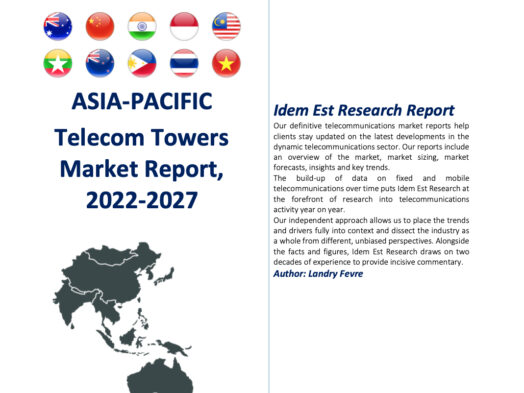Description
WHY YOU SHOULD BUY THE MALAYSIA TELECOMS INDUSTRY REPORT:
- Benefit from the latest market opportunities
- Target business opportunities and risks in the telecoms sector through our reviews of latest industry trends, regulatory changes and major deals, projects and investments
- Understand the threats to your operations and investments and protect your company against future risks
- Gain insight on emerging trends that could support, strengthen or disrupt your activities in the market
- Get a full view of the competitive landscape to assess your market position.
- Forecasts as a key input for successful budgeting and strategic business planning in the telecoms market
- Assess the activities, strategy and market position of your competitors, partners and clients
The Malaysia Telecoms Industry Report, 2024-2031 includes a comprehensive review of the Malaysia market dynamics, market sizing, market forecasts, analysis, insights and key trends and also features the following:
- Overall Telecommunications Market by Major Operators
- Telco Operators Profile, Revenue and EBITDA Mix
- Mobile Subscribers & Revenue Market Overview and Forecasts
- Spectrum Holdings
- IoT Market Overview
- Broadband Subscribers & Revenue Market Overview and Forecasts
- Digital Infrastructure (Fibre, Telecom Towers, Data Centres, Submarine Cables)
- Telecom Tower Market Analysis and Forecast
- Thematics / Opportunities relating to 5G, M&A and e-Commerce
- Telco M&A Transaction Database
EXECUTIVE SUMMARY
Malaysia Telecoms Industry Report at a Glance
The Malaysian telecommunications market is a thriving mobile market with four large network operators, an incumbent fixed-line provider with near-monopoly and the overall market underpinned by strong economic fundamentals, albeit some political uncertainties.
Key Developments:
– The merger of Celcom and Digi is now complete and became the largest telecommunications operator in Malaysia
– FTTH footprint on track to pass 8m premises in 2023
– 5G rollout in Malaysia underway with 61% of the country covered but undertaken by a wholesalegovernment monopoly via a special purpose vehicle, Digital Nasional Berhad (DNB)
– A group of five mobile operators bought a 70% stake in Digital Nasional Bhd (DNB). DNB would offer discounted pricing for 5G wholesale access until the 80% nationwide coverage target is achieved by the end of 2024
– Malaysia’s 3G netowrk was shut down in early 2022
Idem Est Research forecasts that mobile subscriptions will continue to grow in the 2024-31 period and fixed broadband subscribers will also continue to grow and increase its household penetration over the same period.
Over the last 2 years, Malaysia made tremendous progress in improving its FTTH footprint and providing services with speeds of 100Mbps and over to two third of the broadband subscribers.
4G speeds also improved with over 50% of 4G sites now equipped with fibre backhaul as well as 4G coverage reaching over 97% of the population. 5G take-up remains slow with operators dragging their feet to sign-up to resell 5G services from the wholesale DNB network.
Mobile subscribers numbers and revenue are growing strongly and the back of population growth and the market shift to postpaid. Idem Est Research forecasts 40m 5G subscribers by 2031.
Idem Est Research expects the overall telecoms revenue to grow through to 2031 after a marked slow down in 2019 and 2020 due to legacy voice revenue pressure partially offset by mobile data and fixed broadband growth.
Capex Investments
The Capex to GDP ratio remained relatively stable between 2015 and 2018 but has been sliding in 2019 and growing again with DNB building its 5G network from 2022 onwards through to 2027. Telekom Malaysia nearly halved its Capex in 2019 but boosted back its FTTH investments in 2023 while Maxis, CelcomDigi have more consistent investment profiles.
Mobile Subscribers and Revenue
Over the last five years, the market shifted to postpaid as subscribers move to with increased data allowances. Overall, the number of prepaid subscribers decreased significantly. Mobile network operators are facing competitive pressure with the market shifting to legacy prepaid voice and SMS to data-centric usage increasingly becoming the sole offering differentiator.
According to our benchmark study of mobile data pricing, India has the lowest rate per GB at just a few cents per GB, while Australia and China had the biggest cost reduction per GB mostly due to increased data allowance in plans while Singapore remains expensive. Malaysia has the highest monthly download per user while pricing per GB decreased by half for Malaysian users.
Broadband Subscribers – FTTH Push and Fixed Wireless
The Jendela initiative is a Malaysian government program of building full-fibre networks to homes, businesses and government buildings covering 98% of the population by the end of 2025 as well as providing 100% 4G coverage with minimum speeds of 100Mbps.
The broadband market is now experiencing strong growth mostly driven by competition by TIME, Celcom, Maxis and CelcomDigi with Telekom Malaysia still the dominant fixed broadband incumbent.
Telecom Tower Infrastructure getting a boost from the Jendela initiative
The Malasian telecom towers is reaching an estimated over 44,710 towers in 2022. The largest tower company (towerco) is edotco, the infrastructure arm of Axiata also the owner of Celcom, one of the original Malaysian mobile network operators. edotco grew out of the original carve-out of from Celcom.
The remaining share of the towerco market is relatively fragmented owned by mobile operators, Maxis, DiGi, Celcom, U Mobile and Telekom Malaysia. The 13 State-backed telecommunications infrastructure companies are also controlling a large swath of regional coverage, leaving only a small share to private independent towercos.
Mobile operators must contend with the current de-facto exclusivity arrangements for some state-backed companies controlling infrastructure rollout and permits at the state level. In general, the industry structure is quite fragmented and we are expecting MNO tower divestments and towercos consolidation in the future, which will improve industry economics and improve the speed of implementation.
Thematics – Telecoms Infrastructure / 5G / M&A / e-Commerce
Infrastructure funds, pension funds and government funds are assigning high valuation multiples to telecommunications infrastructure assets such as mobile towers, data centres, submarine cable and fibre infrastructure.
Investment funds are assigning high valuation multiples to telecommunications infrastructure assets such as mobile towers, data centres, submarine cable and fibre infrastructure. This report outlines some real market examples of how investors view and value these investments with real industry examples and EV/EBITDA comparatives and benchmarks.
Idem Est Research predicts the next wave of transactions is likely to continue being about “scale” among small ISPs and largely about infrastructure for Telekom Malaysia, Maxis, Axiata and Digi.
In most markets, telcos operators increasingly find inorganic market growth very challenging, provided the limited scope for M&A due to regulatory barriers.
The arrival of 4G moved the Internet off our desktops into our palms and pockets, 5G could transform the network from something we carry around to something taking us around either virtually (augmented reality or virtual reality) or in reality (autonomous vehicles), the 5G outcome and benefits beyond fast connectivity remain largely unknown in terms of business models, investments required and timeline.
KEY COMPANIES MENTIONED IN THIS REPORT:
Allo, Altel, Astro, Axiata, Celcom, CelcomDigi, Digi, edotco, Maxis, OCK, REDtone, Sacofa, Telekom Malaysia, TIME dotCom, Usaha Tegas, U Mobile, ViewQuest and YTL.
Malaysia Telecoms Industry Report – Table of Contents
1 Key Statistics
1.1 Malaysia Population
1.2 Malaysia’s Economy
1.3 Malaysia’s GDP
2 Overall Telecommunications Market, 2017–2031
2.1 Market Overview
2.2 Historical Telecommunications Market Revenue, 2017-2023
2.3 Overall Telecommunications Market Forecast, 2023-2031
2.4 Telecommunications Market Capital Expenditure, 2017-2031
2.4.1 Historical Telecommunications Capex Spend, 2017-2023
2.4.2 Capex to Revenue Benchmark
2.4.3 Telecommunications Capex Spend Forecast, 2023-2031
3 Telecommunications Operators Profile
3.1 Telekom Malaysia Profile
3.1.1 Telekom Malaysia Revenue and EBITDA Mix
3.2 Maxis Profile
3.2.1 Maxis Revenue and EBITDA Mix
3.1 CelcomDigi Profile
3.1.1 CelcomDigi Revenue, EBITDA and Capex Mix
3.1.2 Celcom Profile (Archived)
3.1 Time dotCOM Profile
3.1.1 TIME dotCom Revenue and EBITDA Mix
3.2 U Mobile Profile
3.2.1 Estimated U Mobile Revenue and EBITDA Mix
3.3 Digital Nasional Berhad Profile
3.3.1 Estimated DNB Capex Spending
3.4 Other Players Profile
3.4.1 Other Telecoms Operators
4 Mobile market
4.1 Mobile Subscribers Historical and Forecast, 2017-2031
4.1.1 Mobile Subscribers Historical, 2017-2023
4.1.2 Mobile Subscribers Market Share, 2017-2024
4.1.3 Malaysia Smartphone Share, 2024
4.1.4 Malaysia Mobile Subscribers Forecast, 2023-2031
4.1.5 Malaysia Mobile Subscribers by Generation (2G, 4G & 5G) Forecast, 2023-2031
4.2 Mobile Revenue Historical and Forecast, 2017-2031
4.2.1 Historical Mobile Revenue, 2017-2023
4.2.1 Mobile Revenue Market Share, 2017-2023
4.2.2 Mobile Revenue Forecast, 2023–2031
4.2.3 Mobile Subscribers ARPU, 2017-2031
4.3 Spectrum Holdings
4.3.1 Existing Spectrum Holdings and 5G
4.3.2 5G Rollout
4.3.3 Mobile Frequencies Portfolios Analysis
4.3.4 Spectrum Depth Benchmark by Country
4.4 Mobile Download Data and Pricing Trends
4.5 Mobile Speed Tests
4.5.1 Ookla Mobile Speed Tests
4.6 Internet of Things (IoT)
5 Broadband Market
5.1 Fixed Broadband Subscribers Historical, 2017-2023
5.2 Fixed Broadband Subscribers Forecast, 2023-2031
6 Satellite Internet Connectivity
6.1 Comparing LEO, MEO, and GEO Satellite Orbits
6.1.1 LEO and GEO Satellite Comparison
6.2 Satellite Broadband Providers Operators, 2023
6.3 5G NTN: The Next Generation of Satellite Connectivity
6.3.1 5G NTN Overview
6.3.2 The Rationale Behind 5G NTN
6.3.3 Technical Aspects of 5G NTN
6.3.4 Potential Applications for 5G NTN
6.3.5 Challenges in Implementation
6.3.6 5G NTN Satellite Providers
6.4 Satellite Internet Market Analysis, 2023-2031
6.4.1 Market Landscape of Satellite Broadband Subscribers, 2023
6.5 Malaysia Satellite Broadband Subscribers Forecast, 2023-2031
7 Fixed Telecommunications Infrastructure Investments
7.1 Government Plans – HSBB and NFCP (2010-2020)
7.2 Government Plans – Jendela (2020-2025)
7.3 Submarine Cables
8 Malaysia Telecom Towers Infrastructure Landscape
8.1 Malaysia Telecom Towers Market Analysis, 2023
8.1.1 Malaysia Telecom Towers Market Overview
8.1.2 Malaysia Telecom Towers Background
8.2 Malaysia Telecom Towers & Rooftops Market Forecast
8.2.1 Malaysia Telecom Towers Forecast, 2023-2031
8.2.2 Regulatory Considerations
8.3 edotco Profile
8.3.1 edotco Towers Key Performance Indicators
8.4 Sacofa Profile
8.4.1 Sacofa Key Performance Indicators
8.5 OCK Profile
8.5.1 OCK Key Performance Indicators
8.6 Edgepoint Towers Profile
8.6.1 EdgePoint Towers Key Performance Indicators
8.7 State-Backed TowerCos Profile
8.7.1 State-Backed Towercos Towers Key Performance Indicators
8.8 Telco Infrastructure Comparative
9 Thematics / Opportunities
9.1 Going for Scale
9.2 Going for Scope
9.3 New Telco Operating Model
9.3.1 The Attraction of Infrastructure Multiples
9.4 6G Developments
10 Telco M&A Transactions Database
11 Methodology
12 Copyright Notice
Malaysia Telecoms Industry Report – List of Figures
Figure 1 – Telco sector revenue as % of GDP in Malaysia
Figure 2 –Revenue Profile Historical Mix (MYR m), 2017 – 2023
Figure 3 –EBITDA Profile Historical Mix (MYR m), 2017 – 2023
Figure 4 – Telecommunications Market Revenue Pool, 2023
Figure 5 – Telecommunications Market EBITDA Pool, 2023
Figure 6 – Telecommunications Revenue & EBITDA Share Estimates, 2023
Figure 7 – Total Telecoms Market Revenue and Growth Rate (MYR bn), 2017-2031
Figure 8 – Capex to Revenue Benchmark, 2017-2023
Figure 9 – Telecommunications Capital Expenditure Spend, 2000-2031
Figure 10 – Telekom Malaysia Service Revenue Mix, 2017-2023
Figure 11 – Telekom Malaysia Historical Revenue Mix, 2017 – 2023 (MYR m)
Figure 12 – Maxis Revenue Mix, 2017-2023
Figure 13 – Maxis Historical Revenue Mix (MYR m), 2017-2023
Figure 14 –CelcomDigi Service Revenue Mix, 2017-2023
Figure 15 – CelcomDigi Historical Revenue Mix, 2017-2023 (MYR m)
Figure 16 – Historical Celcom Revenue and EBITDA (MYR m), 2015-2021
Figure 17 – TIME dotCom Historical Revenue Mix, 2017-2023 (MYR m)
Figure 18 – Estimated U Mobile Historical Revenue Mix, 2017-2023 (MYR m)
Figure 19 – Mobile Subscribers Share Comparison, 2017-2024
Figure 20 – Malaysia Mobile Subscriber Share Comparison, 2016-2024
Figure 21 – Mobile Net Adds (000’s) Comparison, 2017-2024
Figure 22 – Mobile Prepaid/Postpaid Net Adds (000’s) Comparison, 2017-2024
Figure 23 – Mobile Subscribers Forecast, 2017-2031
Figure 24 – Malaysia Mobile Subscribers by Generation (2G, 3G, 4G & 5G) Forecast, 2023-2031
Figure 25 – Mobile Revenue Share Comparison, 2017-2023
Figure 26 – Mobile Revenue Forecast, 2023-2031
Figure 27 – Mobile Subscribers ARPU (MYR), 2017-2031
Figure 28 – Subscriptions per MHz of Spectrum, Select Asia-Pacific Countries, 2023
Figure 29 –Mobile Handsets Monthly Download Data, 2017-2023
Figure 30 – Data Pricing Trends in Asia-Pacific (USD per GB per month), 2017-2023
Figure 31 – Asia Pacific Data Pricing Benchmark, 2024
Figure 32 – Spectrum available for IoT in Malaysia
Figure 33 – Broadband Subscribers Share Comparison, 2017-2023
Figure 34 – Malaysia Net-Adds (000’s) by Operators, 2017-2024
Figure 35 – Malaysia Broadband Services by Speed Tiers
Figure 36 – Malaysia Broadband Subscribers Forecast, 2023-2031
Figure 37 – Satellite Deployments Type
Figure 38 –Starlink and OneWeb Satellite Launches per Month (Data until Jan-24)
Figure 39 –Malaysia Satellite Broadband Market Share, 2023
Figure 40 – Malaysia Satellite Broadband Subscribers (k) Forecast, 2023-2031
Figure 41 – Jendela 2020-22 Action Plan
Figure 42 – Malaysia Telecom Towers Market Share, 2023
Figure 43 – Malaysia Telecom Towers Forecast, 2023-2031
Figure 44 – Telecoms Providers EV/EBITDA Ranges
Malaysia Telecoms Industry Report – List of Tables
Table 1 – Malaysia – Key Statistics
Table 2 – Telecommunications Market Revenue by Operators – 2017-2023
Table 3 – Total Telecommunications Market Revenue, 2023-2031
Table 4 – Historical Telecommunications Capex Spend, 2017-2023
Table 5 – Historical Telekom Malaysia Revenue, EBITDA & Capex, 2017-2023
Table 6 – Historical Maxis Revenue and EBITDA Mix, 2017-2023
Table 7 – Historical Digi and CelcomDigi Revenue, EBITDA & Capex, 2017-2023
Table 8 – Historical Celcom Revenue and EBITDA Mix, 2015-2021
Table 9 – Historical TIME dotCom Revenue, EBITDA & Capex, 2017-2023
Table 10 – Historical Estimated U Mobile Revenue, 2017-2023
Table 11 –Estimated DNB Capex Spending, 2021-2027
Table 12 – Historical Mobile Subscribers, 2017-2024
Table 13 – Malaysia Mobile Subscribers Forecast, 2023-2031
Table 14 – Malaysia Mobile Subscribers by Generation (2G, 4G, 5G & 6G) Forecast, 2023-2031
Table 15 – Historical Mobile Service Revenue, 2017-2023
Table 16 – Historical ‘Big 3’ and U Mobile Blended Mobile ARPU, 2017-2023
Table 17 – Mobile Frequencies by Operators and by Band (MHz)
Table 18 – Historical Broadband Subscribers, 2017-2024
Table 19 – Historical Broadband Monthly ARPU, 2017-2024
Table 20 – Malaysia Broadband Subscribers Forecast, 2023-2031
Table 21 – Satellite Orbit Altitudes
Table 22 – LEO and GEO Satellite Comparison
Table 23 – Satellite Broadband Subscribers Operators, 2024
Table 24 – 5G NTN and Satellite Providers, 2023
Table 25 – Indonesia Satellite Broadband Subscribers Forecast, 2023-2031
Table 26 – International Submarine Cable Systems with Landing Stations in Malaysia
Table 27 – Malaysia Telecom Towers Market Analysis, 2023
Table 28 – Malaysia Tenant Indicative Tower Leasing Annual Fees
Table 29 – Malaysia Telecom Towers, Revenue, Mobile Subscribers, Penetration & ARPU Forecast, 2023-2031
Table 30 – edotco Key Performance Indicators, 2023
Table 31 – Sacofa Key Performance Indicators, 2023
Table 32 – OCK Key Performance Indicators, 2023
Table 33 – EdgePoint Towers Key Performance Indicators, 2023
Table 34 – State Backed Company TowerCos Market Analysis, 2023
Table 35 – State-Backed Towercos Towers Key Performance Indicators, 2023
Table 36 – Telekom Malaysia, Maxis, Digi, Axiata and TIME dotcom Telecoms Infrastructure Landscape
Table 37 – Telco Transaction Database, 2014-2023
About this report:
5th Edition
Pages: 88
Author: Landry Fevre
Publication Date: June 2024
License: Single User PDF
Other Idem Est Research Telecoms Country Reports
Australia, Bangladesh, China, India, Indonesia, Japan, New Zealand, Malaysia, Myanmar, Pakistan, Philippines, Singapore, South Korea, Taiwan, Thailand, Vietnam,
Asia Pacific Telecom Towers






